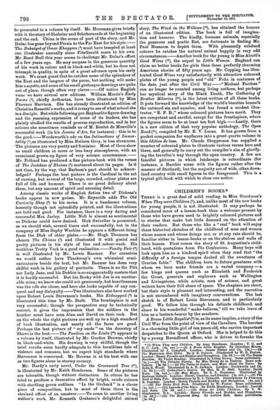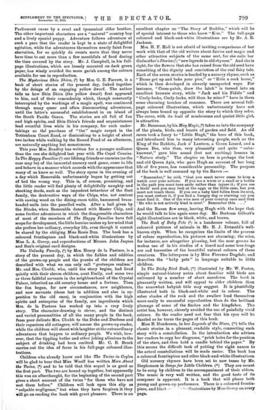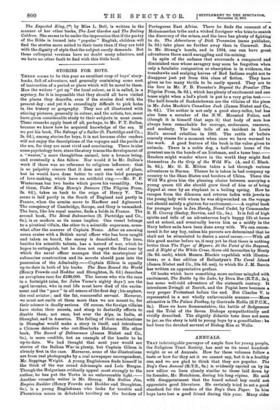CHILDREN'S BOOKS.*
THERE is a great deal of solid reading in Miss Steedman's When They were Children (I), and, unlike most of the new books for young people, it is not illustrated. It may perhaps be considered more of a lesson-book than a welcome present by those who have grown used to brightly coloured pictures and to stories that make but little demand on the attention of their readers. But those who like a "real" book will enjoy these historical sketches of the childhood of men and women whose names and whose doings are, or at any rate should be, familiar either in lesson-books or on the shelves and walls of their homes. First comes the story of St. Augustine's child- hood, with quotations from The Confessions. Many boys will look upon him as a kindred spirit when they read that "the difficulty of a foreign tongue dashed all the sweetness of Grecian fable." The children born to future greatness with whom we here make friends are a varied company — a few kings and queens such as Elizabeth and Frederick the Great, generals and explorers such as Wellington and Livingstone, while artists, men of science, and great writers have their full share of space. The chapters are short, but their style is pleasant and interesting, and the narrative is not encumbered with imaginary conversations. The last sketch is of Robert Louis Stevenson, and is particularly good. We follow him through his delicate childhood, and share in his wonderful " make-believes," till we take leave of him as a lantern-bearer by the seashore.
A Brave Little Royalist (2) is, as its name implies, a story of the Civil War from the point of view of the Cavaliers. The heroine is a charming little girl of ten years old, who carries important despatches to the Queen at Oxford. She is helped to do this by a young Roundhead officer, who is driven to forsake the • (1) When They were Children. By Amy Steedman. (London : T. C. and E. C. Jack. [58. net.]—(2) A Brave Little Royalist. By Dorothea Moore. Illustrated by J. Campbell. London James Nisbet and Co. [58.1—(3) The Mysterious Shin Shsra. By U. E. Farrow. illustrated by W. G. Easton. London : Henry Frowde and Hodder and Stoughton. [2s. 6d.]—(4) The Happy Families. By Violet Bradley. Illustrated by Lilian Govey. Same publishers. [1s.)—(5) The Unlucky Family. By Mrs. Henry de la Pasture. Same pub- lishers. 13s. 6d.]—(6) The Twins in Ceylon, and More About the Twins. By Bella S. Woolf. Illustrated by A. E. Jackson. London : Duckworth and Co. [3s. 6d.]—(7) Godmother's Stories. By Mrs. H. F. Hall. London : David Nutt. [6s. net.]—(8) May Magic. By S. L. Bensusan. Illustrated by Bertram Gilbert. London Heath, Cranton, and Ouseley. [2s. net.]—(9) Th. Book of Baby Pets. Illustrations by E. J. Detmoid. Descriptions by Florence E. Dugdale. London : Henry Frowde and Hodder and Stoughton. [6s. net.] —(10) The Dicky Bird Book. Illustrated by W. Foster. Same publishers. [1s. net.]—(11) Legends of the Stars. By Edith Henderson. Loudon : Jerrold. and Sons. (2s. 6d. net.]—(12) Songs for Little Children. By T. W. Stephenson, B.A. London : Henry Frowde and Hodder and Stoughton. las. 6d.]—(13) The Expected King. By Lettice Bell. Same publishers. [3s. 6d.]
Parliament cause. by a cruel and tyrannical elder brother. The other important characters are a " natural" cotmtry boy and a lively spaniel puppy. Adventure follows adventure at such a pace that the reader is kept in a state of delightful agitation, while the adventurers themselves nearly faint from starvation, for so quickly do events move that they never have time to eat more than a few mouthfuls of food during the time covered by the story. Mr. J. Campbell, in his full- page illustrations, which are loosely mounted on dark green paper, has wisely avoided the more garish among the colours available for use in reproduction.
The Mysterious Shin Shim, (3) by Mrs. G. E. Farrow, is a book of short stories of the present day, linked together by the doings of an engaging yellow dwarf. The author tells us how Shin Shim. (the yellow dwarf) first appeared to him, and of their comradeship which, though constantly interrupted by the workings of a magic spell, was continued through many queer and often disconcerting adventures, until the latter's successful establishment in an island of the South Pacific Ocean. The stories ar•e all full of fun and high spirits, and Shin Shira's friends and acquaintances lead eventful lives while in his company, for such under- takings as the purchase of "the" magic carpet in the Tottenham Court Road, or diminishing to a height of about two inches while walking by the Round Pond of an afternoon, are naturally anything but monotonous.
This year Mrs. Bradley has written for a younger audience than the one she delighted last year• with The Capel Cousins. In The Happy Families (4) our lifelong friends or enemies (as the case may be) of the immortal nursery card game, come to life and behave in a manner which accords with the appearance that many of us know so well. The story opens in the evening of a day which Esmeralda unfortunately began by getting out of bed the wrong way. This is, of course, promising, and the little reader will find plenty of delightfully naughty. and shocking deeds, such as the impudent behaviour of the Soot family, the destructive ways of the Chips, who, not content with sawing wood on the dining-room table, hammered brass- beaded nails into the panelled walls. After a ball given by the Blocks, when Esmeralda danced with Master Chip, and some further adventures in which the disagreeable characters of most of the members of The Happy Families have full scope for development, the little heroine makes up her mind that she prefers her ordinary, everyday life, even though it cannot be shared by the obliging Miss Rosie Bun. The book has a coloured frontispiece and black-and-white illustrations by Miss L. A. Govey, and reproductions of Messrs. John Jaques and Son's original card designs.
The Unlucky Family, (5) by Mrs. Henry de la Pasture, is a story of the present day, in which the foibles and oddities of the grown-up people and the pranks of the children are described with what we can only call "grotesque realism." Mr. and Mrs. Chubb, who, until the story begins, had lived quietly with their eleven children, aunt Emily, and some two or three faithful servants in the neighbourhood of the Crystal Palace, inherited an old country house and a fortune. Then the fun began, for new circumstances, new neighbours, and new servants (these last in addition and also in op- position to the old ones), in conjunction with the high spirits and enterprise of the family, are ingredients which Mrs. de la Pasture has worked up into a very lively story. The character-drawing is clever, and the distinct and varied personalities of all the many people in the book, from poor delicate Mrs. Chubb to the Duke and Duchess and their rapacious old cottagers, will amuse the grown-up reader, while the children will shout with laughter at the extraordinary adventures that happen to ordinary people. We wish, how- ever, that the tippling butler and other joking allusions to the subject of drinking had been omitted. Mr. C. E. Brock carries out the idea of farce in his full-page coloured illus- trations.
Children who already know and like The Twins in Ceylon will be glad to hear• that Miss Woolf has written More About the Twins, (6) and to be told that this sequel is as good as the first part. The two are bound up together, but apparently this was an afterthought, for the beginning of the second part gives a short account of the twins " for those who have not met them before." Children will look upon this slip as "culpable negligence," but when they have forgiven it they will go on reading the book with great pleasure. There is an
excellent chapter on "The Story of Buddha," which will be of special interest to those who know " Kim." The full-page coloured and black-and-white illustrations are by Mr. A. E. Jackson.
Mrs. H. F. Hall is not afraid of inviting comparisons of her work with that of the old writers about fairies and magic and other attractive subjects of the same sort, for she calls her Godmother's Stories (7) "new legends to old rhymes." And she is
right, for the flowers that she has raised from the old seed have something of the dignity and conviction of the real fairy tale.
Each of the seven stories is beaded by a nursery rhyme, such as "Dame get up and bake your pies," or "Ride a cock horse," which is then developed in cleverly unexpected ways. For instance, " Cross-patch, draw the latch" is turned into an excellent brownie story, while " Jack and his Fiddle " and " Curly-locks, Curly-locks, wilt thou be mine ? " have in them some charming touches of romance. There are several full- page coloured illustrations, which unfortunately have not always been bound up opposite the story to which they refer.
The cover, with its trail of mushrooms and quaint little girl, is attractive.
Mr. Bensusan, by his May Magic, (8) takes us into the company
of the plants, birds, and beasts of garden and field. An old raven took a fancy to "Little Hugh," the hero of this book, and introduced him to many interesting people, such as the King of the Rabbits, Jack o' Lantern, a Green Lizard, and a Queen Bee, who then, very pleasantly and quite " unbe- knownst," gave him sound (but not exciting) lessons in "Nature study." The chapter on bees is perhaps the best and old Queen Apia, who gave Hugh an account of her long life of five years, has considerable personality. The purpose of the book is well summed up by the Raven :-
"Remember," he said, "that you must never cease to keep a watch over your actions. If you see a worm or a snail or a beetle in the path you must turn aside rather than injure it; if you see a birds' nest you may look at the eggs or the little ones, but you must not touch them. If you see a baby bird fallen from its nest, you must restore it, if you find a hungry dog or starving cat you must feed it. One of the wise men of your country once said that ' He who is not actively kind is cruel.' Remember this. . .
And the Raven flew away, leaving Hugh with the hope that be would talk to him again some day. Mr. Bertram Gilbert's eight illustrations are in black, white, and brown.
The Book of Baby Pets ('l is a handsome volume, full of coloured pictures of animals in Mr. E. J. Detmold's well- known style. When be recognizes the limits of the process of colour reproduction, his pictures are charming; the mice, for instance, are altogether pleasing, but the sour• greens he makes use of in his studies of a lizard and some tree-frogs are sad travesties of the beautiful natural colours of these creatures. The letterpress is by Miss Florence Dugdale, and describes the "baby pets" in language suitable to little children.
In The Dicky Bird Book, (10) illustrated by Mr. W. Foster, simple natural-history notes about familiar• wild birds are enlivened by a number of short anecdotes. The book is pleasantly written, and will appeal to older children than the somewhat babyish title may suggest. It is plentifully illustrated both in black-and-white and in colour•. The sober shades of the rook and the swallow lend themselves
more easily to successful reproduction than do the brilliant plumage of some of the finches and the kingfisher. Th3 artist has, however, cleverly avoided the use of painfully vivid colours. So the reader need not fear• that his eyes will b3 dazzled as he turns the pages of this book.
Miss E. Henderson, in her Legends of the Stars, (11) tells the classic stories in a pleasant, readable style, connecting each story with a constellation. In the introduction she advises her• readers to copy her diagrams, "prick holes for the position of the stars, and then hold a candle behind the paper." By this means the difficult task of putting the right names to
the actual constellations will be made easier. The book has a coloured frontispiece and other black-and-w bite illustrations. Old nursery rhymes have been set to new tunes by Mr.
Stephenson in Songs for Little Children. (12) They are meant
to be sung by children to the accompaniment of their elders. The music is very well written, and the good taste of its composer is apparent. It is a book that will please both young and grown-up performers. There is a coloured frontis-
piece, and black ' • '• • 1•• illustrations by Miss Govey on every
page. The Expected King, ('s) by Miss L. Bell, is written in the manner of her other books, The Lost Garden and The Boiling Caldron. She seems to be under the impression that if the poetry of the Bible is turned into " popular" English, children will find the stories more suited to their taste than if they are told with the dignity of style that the subject surely demands. But these colloquial versions have no doubt many admirers, and we have no other fault to find with this little book.
































































 Previous page
Previous page